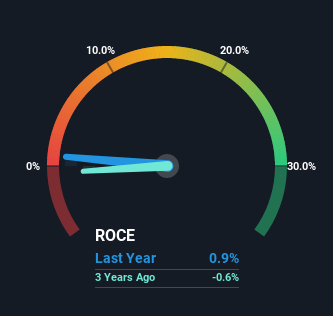
Finding a business that has the potential to grow substantially is not easy, but it is possible if we look at a few key financial metrics. Ideally, a business will show two trends; firstly a growing return on capital employed (ROCE) and secondly, an increasing amount of capital employed. If you see this, it typically means it's a company with a great business model and plenty of profitable reinvestment opportunities. Having said that, from a first glance at Urja Global (NSE:URJA) we aren't jumping out of our chairs at how returns are trending, but let's have a deeper look.
Return On Capital Employed (ROCE): What is it?
If you haven't worked with ROCE before, it measures the 'return' (pre-tax profit) a company generates from capital employed in its business. To calculate this metric for Urja Global, this is the formula:
Return on Capital Employed = Earnings Before Interest and Tax (EBIT) ÷ (Total Assets - Current Liabilities)
0.0088 = ₹15m ÷ (₹5.4b - ₹3.6b) (Based on the trailing twelve months to December 2021).
Thus, Urja Global has an ROCE of 0.9%. In absolute terms, that's a low return and it also under-performs the Semiconductor industry average of 6.4%.
Check out our latest analysis for Urja Global

While the past is not representative of the future, it can be helpful to know how a company has performed historically, which is why we have this chart above. If you're interested in investigating Urja Global's past further, check out this free graph of past earnings, revenue and cash flow.
What Does the ROCE Trend For Urja Global Tell Us?
Things have been pretty stable at Urja Global, with its capital employed and returns on that capital staying somewhat the same for the last five years. It's not uncommon to see this when looking at a mature and stable business that isn't re-investing its earnings because it has likely passed that phase of the business cycle. With that in mind, unless investment picks up again in the future, we wouldn't expect Urja Global to be a multi-bagger going forward.
Another point to note, we noticed the company has increased current liabilities over the last five years. This is intriguing because if current liabilities hadn't increased to 67% of total assets, this reported ROCE would probably be less than0.9% because total capital employed would be higher.The 0.9% ROCE could be even lower if current liabilities weren't 67% of total assets, because the the formula would show a larger base of total capital employed. Additionally, this high level of current liabilities isn't ideal because it means the company's suppliers (or short-term creditors) are effectively funding a large portion of the business.
The Bottom Line On Urja Global's ROCE
In a nutshell, Urja Global has been trudging along with the same returns from the same amount of capital over the last five years. Yet to long term shareholders the stock has gifted them an incredible 1,154% return in the last five years, so the market appears to be rosy about its future. However, unless these underlying trends turn more positive, we wouldn't get our hopes up too high.
One more thing to note, we've identified 3 warning signs with Urja Global and understanding these should be part of your investment process.
While Urja Global isn't earning the highest return, check out this free list of companies that are earning high returns on equity with solid balance sheets.
New: AI Stock Screener & Alerts
Our new AI Stock Screener scans the market every day to uncover opportunities.
• Dividend Powerhouses (3%+ Yield)
• Undervalued Small Caps with Insider Buying
• High growth Tech and AI Companies
Or build your own from over 50 metrics.
Have feedback on this article? Concerned about the content? Get in touch with us directly. Alternatively, email editorial-team (at) simplywallst.com.
This article by Simply Wall St is general in nature. We provide commentary based on historical data and analyst forecasts only using an unbiased methodology and our articles are not intended to be financial advice. It does not constitute a recommendation to buy or sell any stock, and does not take account of your objectives, or your financial situation. We aim to bring you long-term focused analysis driven by fundamental data. Note that our analysis may not factor in the latest price-sensitive company announcements or qualitative material. Simply Wall St has no position in any stocks mentioned.
About NSEI:URJA
Urja Global
Engages in the design, consultancy, integration, supply, installation, commissioning, and maintenance of off-grid and grid-connected solar power plants and decentralized solar applications in India.
Adequate balance sheet with questionable track record.
Market Insights
Community Narratives



